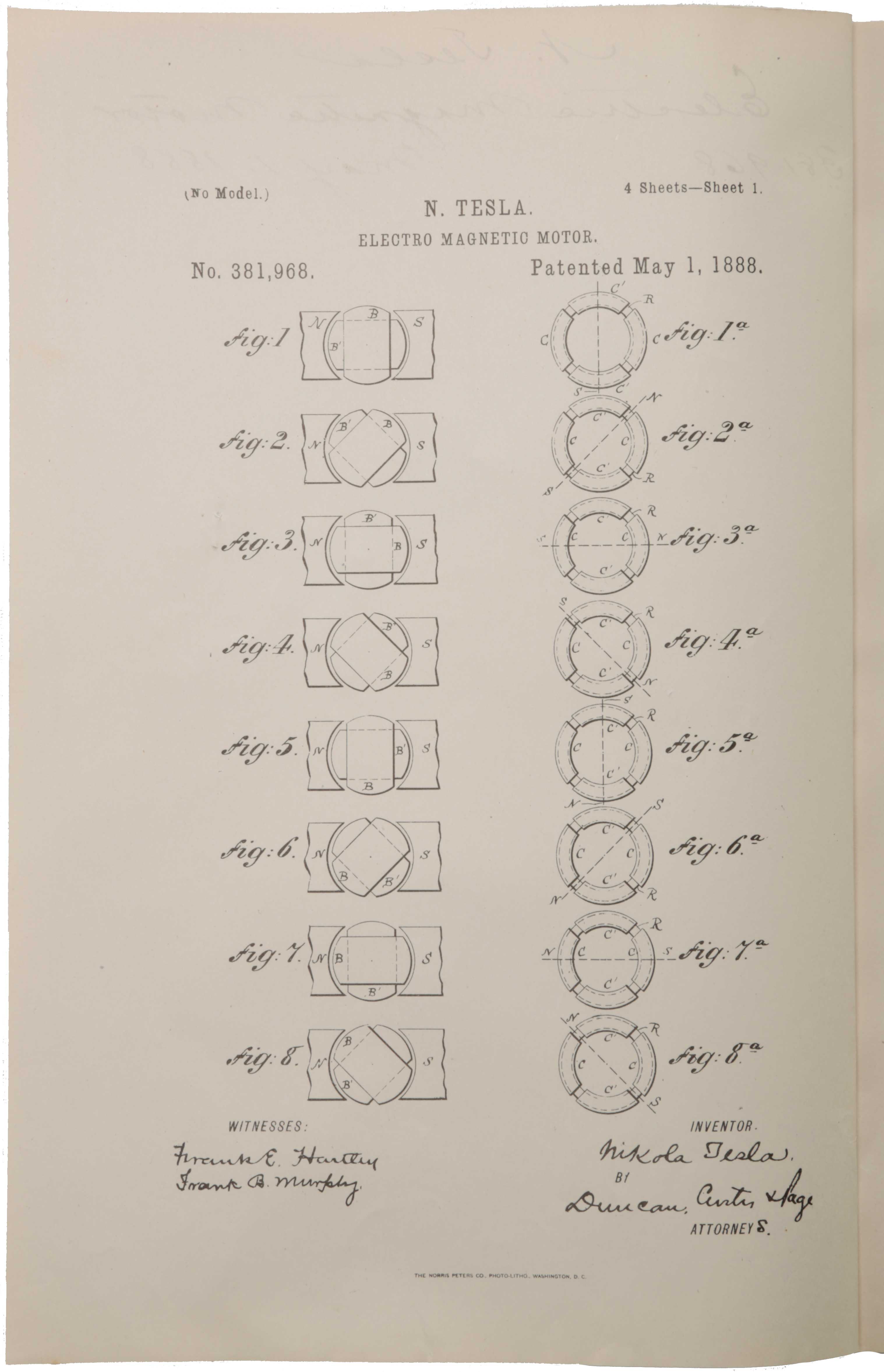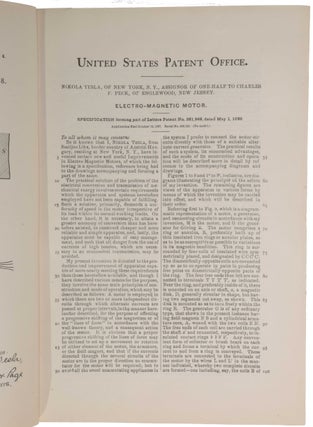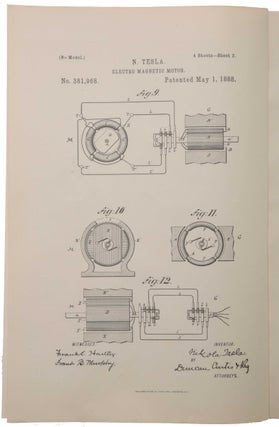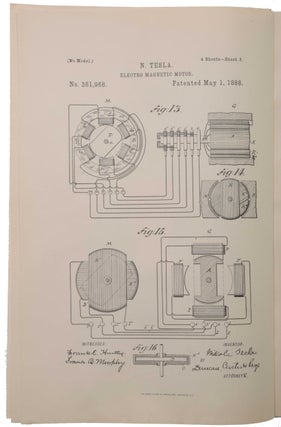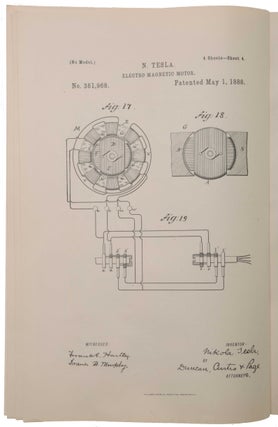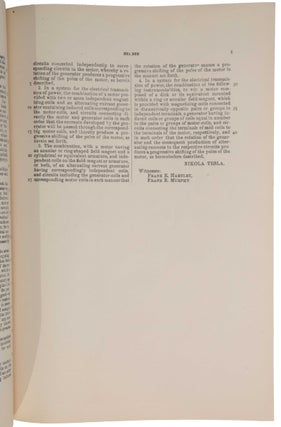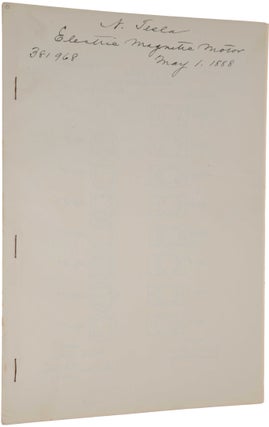Electro Magnetic Motor. Patent No. 381,968. Application filed October 12, 1887; patented May 1, 1888.
Washington, DC: Norris Peters Co. Photo-Lithographer for the United States Patent Office, [1888]. First edition, extremely rare, of Tesla’s most important patent, and the invention for which he was inducted into the National Inventors Hall of Fame. It sparked the ‘war of the currents,’ dramatized in the 2017 movie ‘The Current War’. This pitched Thomas Edison, who championed direct current (DC) power transmission, against Tesla and George Westinghouse, who promoted alternating current (AC) transmission: AC power transmission was eventually adopted in the United States and around the world. In the early 1880s, most power transmission in the US was by direct current. Edison argued that DC was safer to use than AC. Westinghouse, his rival, promoted AC power transmission, since by using a transformer the voltage of an AC current could be stepped up at the source, thus reducing power losses and allowing power transmission over longer distances (for a given amount of power transmitted, the loss is inversely proportional to the square of the voltage). Westinghouse was already using an alternating current system developed by the French inventor Lucien Gaulard and the English entrepreneur John Dixon Gibbs. What was missing was an AC motor, which would allow AC power to not only light cities, but to power appliances in homes and factories. Tesla’s motor, described in the offered patent, broke with previous DC motors by eliminating the need for a commutator—an external switch that reversed the direction of the current in the rotor every 180 degrees to make sure it stayed spinning in one direction. Working out of a machine shop in New York, he designed a new kind of motor – an AC motor – which did not need a commutator. Instead of mechanical switches, a rotating magnetic field spun the rotor used to convert electrical energy into mechanical power. Tesla believed that his motor would solve three major problems. His motor could produce a uniform speed irrespective of its load; it was cheaper, simpler, and more reliable than existing systems; and, it was easy to maintain, reducing the hazards of high-voltage currents. Tesla received a patent on this invention in May 1888 and read a paper, ‘A New System of Alternate-Current Motors and Transformers’, before the American Institute of Electrical Engineers at Columbia University on May 16, 1888. Tesla sold his invention to the Westinghouse Electric Company for $60,000, and AC soon became the standard for powering homes and offices in the United States. “He was an inventor, an engineer, a scientist and an oddball. It was Tesla, not Marconi who invented radio … more than any one man, Nikola Tesla is responsible for the twentieth century” (Hunt, introduction to Nikola Tesla: My Inventions and Other Writings (2011)). In his speech presenting Tesla with the Edison medal in 1917, B. A. Behrend, Vice President of the American Institute of Electrical Engineers, stated: “Were we to seize and eliminate from our industrial world the result of Mr. Tesla’s work, the wheels of industry would cease to turn, our electric cars and trains would stop, our towns would be dark and our mills would be idle and dead. His name marks an epoch in the advance of electrical science.” “Patents issued to Nikola Tesla represent the culmination of his creative efforts and, therefore, must be considered as a basic source of information” (Ratzlaff, Dr. Nikola Tesla. Selected Patent Wrappers from the National Archives, pp. vii-viii). Not on OCLC. No copies in auction records. “Tesla was born in July 1856 in Smiljan, Lika, a region of Croatia, the son of a Serbian Orthodox priest. He studied at the Polytechnic Institute in Graaz, Austria, and the University of Prague, initially intending to specialize in physics and mathematics, against his family's desire that he follow his father in an ecclesiastical career. But he soon became fascinated with electricity, and began his career as an electrical engineer with a Hungarian telephone company in 1881, which is where he first devised the concept of the induction motor. “In February 1882 he discovered the effects of a rotating magnetic field, which has found widespread application in electrical devices that use alternating current. “He spent some time with the Continental Edison Company in Paris designing dynamos, and in 1883 he built a prototype of the induction motor and ran it successfully. “He came to the US the following year and took a job in Thomas Edison's lab, but the two men quickly found themselves at odds over direct current (DC) versus alternating current (AC). Edison espoused DC, which flows continuously in one direction, whereas AC typically changes direction 50 or 60 times per second. With a transformer, the AC voltage can be stepped up, and the current correspondingly stepped down, to minimize resistive heating losses in the transmission lines over long distances. In a DC system, line losses required additional power stations at two-mile intervals. “Tesla developed polyphase alternating current systems of generators, motors and transformers, eventually holding 40 basic US patents. These were bought by George Westinghouse, who was determined to supply America with the Tesla system, which eventually won out as the superior technology and became the standard power in the 20th century” (APS News, vol. 12, no. 5, May 2003). “Tesla’s idea for the AC motor had its genesis in an incident that occurred while he was a student at the Austrian Polytechnic School in Graz. A professor Poeschl, who taught physics, brought a Gramme dynamo into class one day and demonstrated its operation. The dynamo produced direct current (DC) using a commutator that created an excessive amount of sparking. Seeing how inefficient the dynamo was, Tesla intuitively knew that the commutator was unnecessary, and that AC could be used instead of DC to provide power to devices, such as motors. Tesla made his opinion known to the class and was instantly met with derision from professor Poeschl, who spent the rest of the class making fun of Tesla. From that point forward, Tesla was determined to find a way to eliminate the commutator and use AC directly without any intermediary devices. “At stake, in effect, was the future of industrial development in the United States, and whether Westinghouse’s alternating current or Edison’s direct current would be the chosen technology. “It was at this time that Edison launched a propaganda war against alternating current. Westinghouse recalled: ‘I remember Tom [Edison] telling them that direct current was like a river flowing peacefully to the sea, while alternating current was like a torrent rushing violently over a precipice. Imagine that! Why they even had a professor named Harold Brown who went around talking to audiences … and electrocuting dogs and old horses right on stage, to show how dangerous alternating current was.’ “Meanwhile, a murderer was about to be executed in the first electric chair at New York’s Auburn State Prison. Professor Brown had succeeded in illegally purchasing a used Westinghouse generator in order to demonstrate once and for all the extreme danger of alternating current. The guinea pig was William Kemmler, a convicted ax-murderer, who died horribly on August 6, 1890, in ‘an awful spectacle, far worse than hanging.’ The technique was later dubbed ‘Westinghousing.’ “In spite of the bad press, good things were happening for Westinghouse and Tesla. The Westinghouse Corporation won the bid for illuminating The Chicago World’s Fair, the first all-electric fair in history. The fair was also called the Columbian Exposition — in celebration of the 400th Anniversary of Columbus discovering America. Up against the newly formed General Electric Company (the company that had taken over the Edison Company), Westinghouse undercut GE's million-dollar bid by half. Much of GE’s proposed expenses were tied to the amount copper wire necessary to utilize DC power. Westinghouse's winning bid proposed a more efficient, cost-effective AC system. “The Columbian Exposition opened on May 1, 1893. That evening, President Grover Cleveland pushed a button and a hundred thousand incandescent lamps illuminated the fairground's neoclassical buildings. This ‘City of Light’ was the work of Tesla, Westinghouse and twelve new thousand-horsepower AC generation units located in the Hall of Machinery. In the Great Hall of Electricity, the Tesla polyphase system of alternating current power generation and transmission was proudly displayed. For the twenty-seven million people who attended the fair, it was dramatically clear that the power of the future was AC. From that point forward more than 80 percent of all the electrical devices ordered in the United States were for alternating current” (https://www.pbs.org/tesla/ll/ll_warcur.html). US Patent Office lithographs, such as that offered here, were produced in an edition of 150 copies starting in 1871, reduced to 100 copies from 1891. Copies were sent to the capital of each State and Territory, and to the office of the clerk of each US District Court. Thus, only a very small number of the patents could have been sold. Public demand was instead met by the Official Gazette of the USPO, published initially twice-yearly, which was a digest of the patents filed, each one summarized in a few lines.
“Tesla obsessed over the issue of harnessing AC for the next four years. Finally, in February of 1882, he had his epiphany. While walking at sunset with his friend Antal Szigeti in a park in Budapest, reciting stanzas from Goethe's Faust, Tesla suddenly had a vision in his mind of the principles of his AC motor system. He grabbed a stick and drew diagrams of the operation of the system in the sand. These diagrams would later appear in the 361,968 patent as Figs. 1-8a.
“What Tesla had invented was a generator having an armature core wound with two coils B B' that was rotated between two field magnets to produce two AC currents that were ninety degrees out of phase with each other. These two currents were supplied to the motor. One AC current was carried by wires to a pair of coils CC of the motor and the other AC current was carried by wires to coils C'C' of the motor. In the motor, the coils CCC'C' were arranged around the circumference of an iron ring R, with the coils CC being arranged diametrically opposite each other and the coils C'C' being arranged diametrically opposite each other. A magnetic disk D mounted on a shaft was rotatably disposed inside the ring R.
“The provision of the out-of-phase AC currents to the coils CCC'C' created a rotating magnetic field. This rotating magnetic field, in turn, induced an electric current in the magnetic disk D, which produced its own magnetic field that opposed the rotating magnetic field. The interaction between the two magnetic fields caused the magnetic disk D to rotate. Since the motor ran due to the induction of electric current in the magnetic disk D, this type of motor has since become known as an AC induction motor.
“A year after his epiphany, Tesla built a model of his AC induction motor, while he was working in France. However, he did not pursue patent protection for his invention until late 1887, after he had immigrated to the U.S. On October 12, 1887, Tesla filed the application for the 361,968 patent and soon after filed six more patent applications for various features of his AC motor system. All seven applications issued as patents on May 1, 1888. Also in May of 1888, Tesla delivered his seminal lecture to the American Institute of Electrical Engineers, entitled ‘A New System of Alternating Current Motors and Transformers’ in which he described in very simple and lucid terms the operation of his AC inductive motor system.
“After reading Tesla' seminal lecture, George Westinghouse became interested in Tesla's motor system. At the time, George Westinghouse was developing an AC power system for his lighting system, which was in competition with Thomas Edison's DC lighting system. Westinghouse quickly negotiated a deal with Tesla, pursuant to which Westinghouse purchased Tesla's patents for $20,000 in cash and $50,000 in notes, payable in three installments. Westinghouse also agreed to pay Tesla royalties of $2.50 per AC horsepower produced by each Tesla motor.
“Westinghouse’s purchase of Tesla’s AC motor system kicked off a full-scale industrial war between Westinghouse and Thomas Edison, who advocated DC power systems. The war would decide whether AC or DC would become the dominant mode of power supply in the U.S.” (http://www.patentlyinteresting.com/may-1.html).
4to (290 x 203 mm), pp. [1], 2-5, [1, blank], with four leaves of diagrams printed on verso only. Stapled as issued.
Item #5896
Price: $60,000.00

